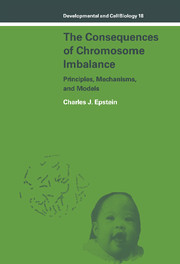Book contents
- Frontmatter
- Contents
- Preface
- Glossary
- PART I INTRODUCTION
- PART II CLINICAL OBSERVATIONS
- PART III THE THEORETICAL MECHANISMS AND ISSUES: THE PRIMARY AND SECONDARY EFFECTS OF ANEUPLOIDY
- 4 Gene dosage effects
- 5 Metabolic pathways, transport systems, and receptors
- 6 Regulatory systems
- 7 Assembly of macromolecules, cellular interactions, and pattern formation
- 8 Type and countertype
- 9 Nonspecific effects of aneuploidy
- PART IV EXPERIMENTAL SYSTEMS FOR THE STUDY OF MAMMALIAN AND HUMAN ANEUPLOIDY
- PART V THREE MAJOR CLINICAL PROBLEMS OF HUMAN ANEUPLOIDY
- PART VI CONCLUSION
- Appendix: Standard karyotypes of man and mouse and human cytogenetic nomenclature
- References
- Index
5 - Metabolic pathways, transport systems, and receptors
Published online by Cambridge University Press: 14 October 2009
- Frontmatter
- Contents
- Preface
- Glossary
- PART I INTRODUCTION
- PART II CLINICAL OBSERVATIONS
- PART III THE THEORETICAL MECHANISMS AND ISSUES: THE PRIMARY AND SECONDARY EFFECTS OF ANEUPLOIDY
- 4 Gene dosage effects
- 5 Metabolic pathways, transport systems, and receptors
- 6 Regulatory systems
- 7 Assembly of macromolecules, cellular interactions, and pattern formation
- 8 Type and countertype
- 9 Nonspecific effects of aneuploidy
- PART IV EXPERIMENTAL SYSTEMS FOR THE STUDY OF MAMMALIAN AND HUMAN ANEUPLOIDY
- PART V THREE MAJOR CLINICAL PROBLEMS OF HUMAN ANEUPLOIDY
- PART VI CONCLUSION
- Appendix: Standard karyotypes of man and mouse and human cytogenetic nomenclature
- References
- Index
Summary
Secondary effects of aneuploidy
In earlier discussions of the effects of aneuploidy (Weil and Epstein, 1979; Epstein et al., 1981), the effects were divided into two categories – primary and secondary. The term “primary” was used to refer to the gene dosage effects discussed in the previous chapter, and “secondary” to denote all of the effects consequent to the primary ones (Fig. 5.1). The major reason for drawing this distinction was to focus attention on the fact that the primary gene dosage effects do not in themselves explain the deleterious outcomes of aneuploid states and that it is necessary to consider the functional or secondary consequences of these quantitative alterations on the synthesis of gene products. The significance of an aneuploidy-produced increase or decrease in the synthesis of a gene product must therefore be understood in terms of the function of the product and the alterations in this function which result from a change in the quantity of the gene product. In this context, the term “function” is being used in a very general sense and refers to whatever role the gene product has in the development, structure, or metabolism of the organism.
In addition to the distinction between primary and secondary effects of aneuploidy, a distinction was also made between two categories of secondary effects – direct and indirect (Fig. 5.1).
- Type
- Chapter
- Information
- The Consequences of Chromosome ImbalancePrinciples, Mechanisms, and Models, pp. 85 - 112Publisher: Cambridge University PressPrint publication year: 1986



